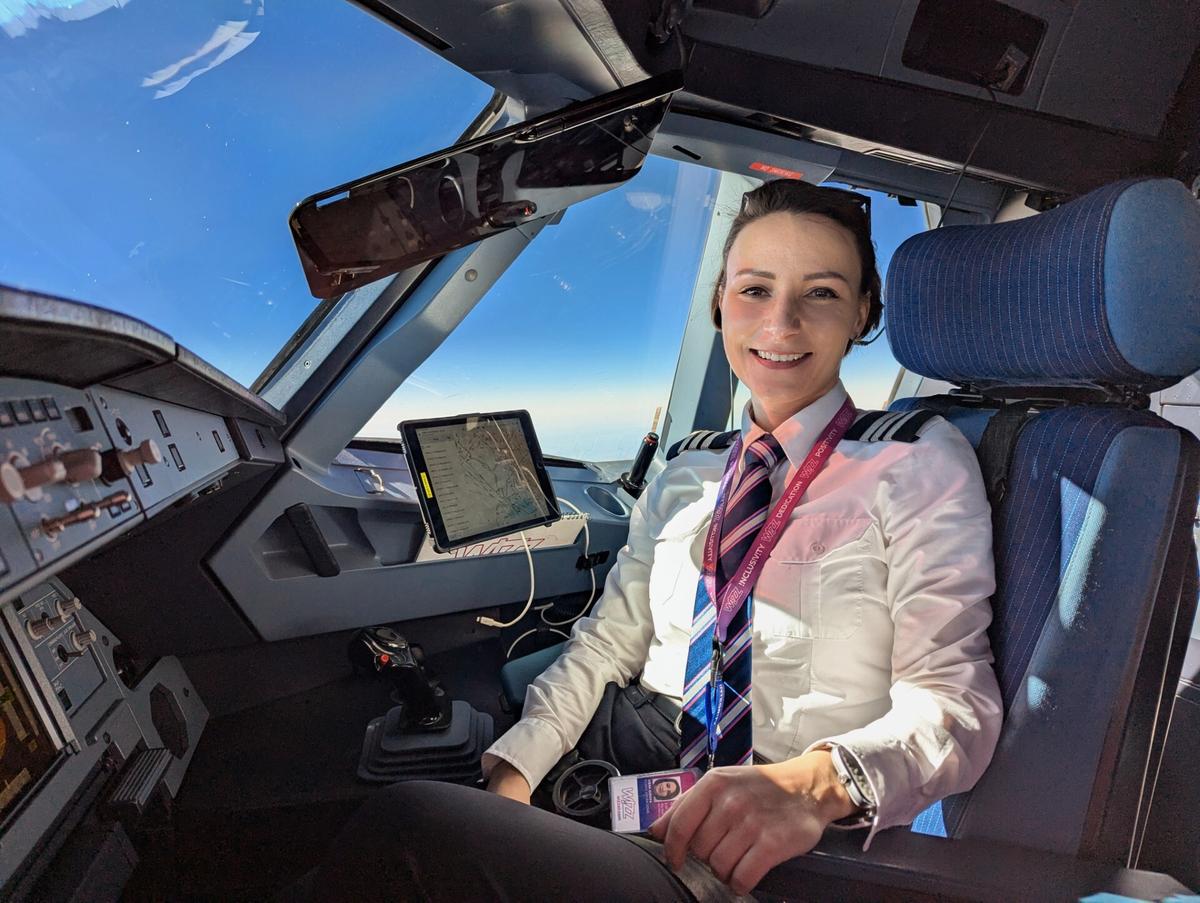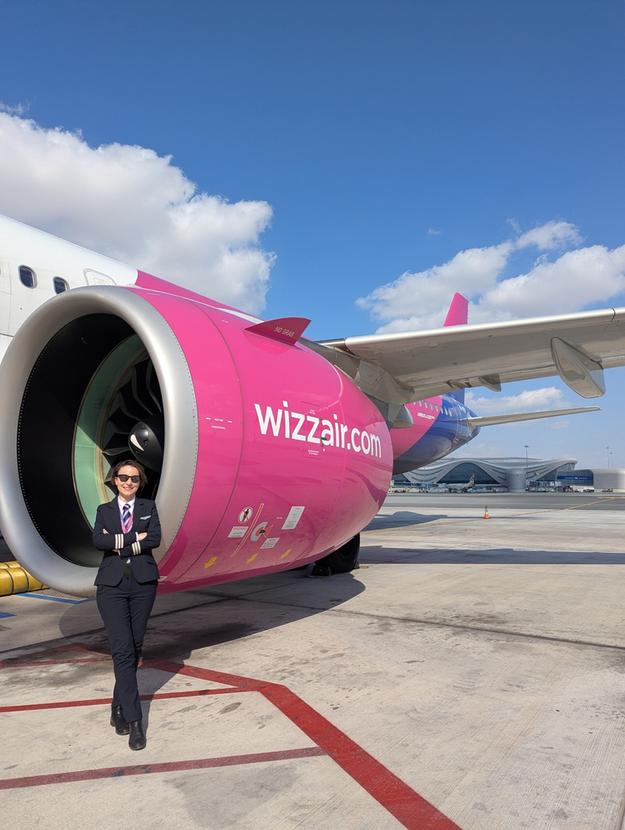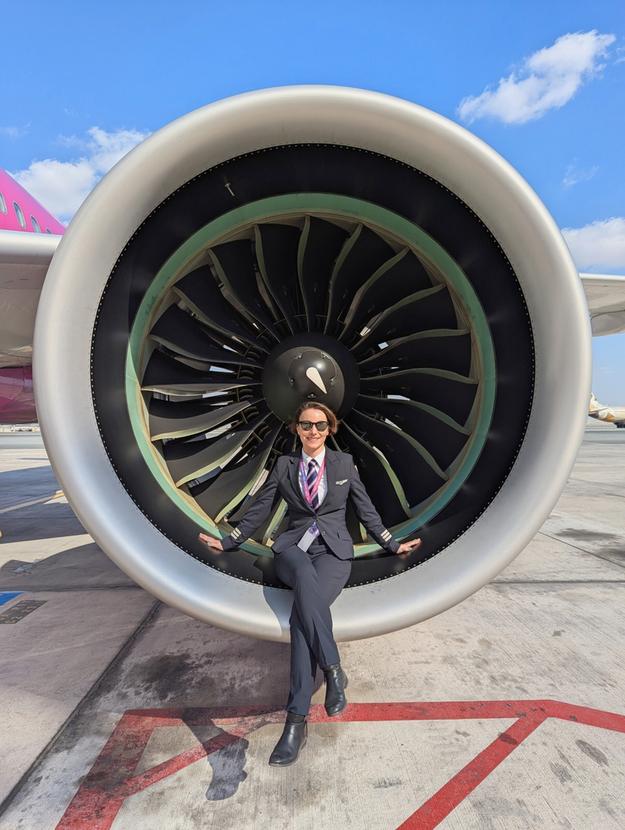Vierka Šidová was too afraid to say out loud that she wanted to be a pilot when she was a child. Today, she has been flying for Wizz Air for two years.
The 30-year-old from Zvolen, central Slovakia, developed her love of flying in Očová, a village near Zvolen with an airfield. Every year, her parents took her to air shows. She decorated her childhood bedroom with stickers of MiG fighter jets.
However, she frequently encountered comments suggesting that, as a girl, she had no business becoming a pilot. She convinced herself that studying IT would be a more practical choice – but she could not let go of her dream.
To become a commercial pilot, she had to log hundreds of flight hours and memorise thousands of exam questions. Determined, she set out to prove to her parents that she was serious about flying.
Did you start flying while at university?
I enrolled at the Faculty of Electrical Engineering and Informatics (FEI). I saw a billboard advertising a scholarship of over €1,000 for students at FEI. But once I started, I realised it wouldn’t be easy.
Only about eight out of 300 students received it. During my first semester and exam period, I spent all my time in my dorm in Bratislava, retaking every subject until I improved my grades. Many of my classmates couldn’t understand why I was putting in so much effort.
But I managed to get the scholarship and eventually completed my master’s degree in applied informatics, specialising in information security.
How old were you when you first started flying?
I began my glider training at 19. Every weekend, I travelled from Bratislava to Očová so I could be at the airfield.
Flying gliders depends on many factors, especially weather conditions, and you also need a ground crew. Sometimes, if the weather wasn’t suitable, we simply couldn’t fly.
How long did it take you to learn to fly gliders?
In the end, I didn’t complete the course because, as soon as the season ended, I immediately began training for my Private Pilot Licence (PPL) at a flight school in Žilina, northern Slovakia. Since you can’t take two flying courses at the same time, I had to pause my glider training.
Every weekend, I travelled to Žilina. To complete the course, I had to pass theoretical exams at the Transport Authority – about 2,500 questions in Slovak. The practical part involved 45 flight hours. I trained on a Cessna 152, which remains my favourite aircraft.
What was the next step?
I logged 45 hours in a few months, but to continue training as a commercial pilot, I needed a total of 200 hours. Once I reached that milestone, I moved on to further training modules at Seagle Air Academy in Trenčín, western Slovakia.
Did you have to take theoretical exams again for your commercial pilot’s licence?
Yes, I had to pass the airline transport pilot theory exam. The tests covered 14 subjects, including meteorology, aerodynamics, and aviation law – over 15,000 questions in English. I’d say it was just as demanding as a university degree.
That sounds like a tough journey. Did you have any free time at university?
Yes, but I always wanted to spend it flying. It might sound awful that I was constantly studying, but when you’re learning something you love, it doesn’t feel like a chore. I remember going through the questions and feeling excited. It wasn’t the same struggle as studying IT, which didn’t interest me as much.
How much did it all cost?
To be honest, I never calculated the total amount – probably out of fear! But roughly, it was around €60,000 before I was even in a position to apply to an airline.
Do you remember the first time you flew an aircraft? What was it like?
It’s a funny story – I first got to fly a plane during an exchange programme in the US. I was staying with a host family, and their uncle owned a small twin-engine aircraft. He asked if I’d like to fly with him from Delaware to New York. I was thrilled.
It was my first time in a small aircraft. During the flight, he let me take the controls during descent. But it felt incredibly heavy – I was struggling and too embarrassed to admit I needed more strength. So I stayed silent. He eventually took over and landed the plane.
That moment made me doubt whether I was strong enough to be a pilot. Later, when I started flying properly, I learned that aircraft can be trimmed to balance the controls, eliminating unnecessary force. In the US, the plane had simply been misbalanced – but I hadn’t known that at the time because I was too shy to ask.
Last year, I went back to the US for my sister’s wedding and told that same uncle that I was now flying commercial jets. He was proud of me.
When you finished flight school, did you already have your sights set on Wizz Air?
I always wanted to fly an Airbus. Since I wanted to live as close to home as possible, Wizz Air was my only option. They used to have a base in Košice, but now the closest ones are in Vienna, Budapest, and Kraków. I hoped to eventually get stationed closer to home – but I started out in Bucharest.
What were the requirements to get hired?
I was selected through a highly competitive interview process in Budapest, which lasted two days and had five rounds. Out of 80 qualified pilots, only 19 of us were chosen.
The first round was a short test based on the 15,000 questions I had studied years earlier. The second involved group exercises where we were split into teams to solve logical puzzles. The outcome didn’t matter – they were observing how we worked as a team.
I had read about the interview process and knew that it was best to participate but not too much. But in my case, no one in my team took charge, and things were getting critical. So I stepped up and led the task.
Afterwards, two captains who were assessing us said they expected a summary from “everyone except me.” I thought I’d overstepped and would be eliminated. But it turned out to be the opposite – they selected me, which completely shocked me.
What happened next?
There was a technical interview with two captains, where they asked me about my theoretical knowledge, experience, and preferred base location. Then came a full-flight simulator test on the Airbus A320, where I had to fly specific parts of a flight. The final stage was a series of psychometric tests.
Only 6 percent of pilots are women. Have you faced gender stereotypes in your job?
I think a lot of girls grow up without even realising that being a pilot is an option. Even though more women are studying technical subjects like IT, the number of female pilots isn’t increasing as quickly. And yet, women bring real value to aviation.
It can also be challenging being in a predominantly male environment. You’re aware of being in the minority. But overall, I’ve mostly had positive reactions to my career. Of course, there are always people who don’t like it.
How did they show it?
When I worked as a parachuting pilot, I had closer interactions with passengers. Some men would test me – asking me technical questions while I was refuelling the plane, assuming I wouldn’t know the answers. When I responded correctly, they were visibly shocked that a 160 cm-tall woman was about to fly the aircraft.
Now you are a First Officer, the co-pilot assisting the captain. How long does it take to become a captain?
Both the captain and First Officer are pilots, and we take turns flying the aircraft while the other monitors. But the captain has final responsibility for the aircraft.
The upgrade to captain happens after gaining enough experience. At Wizz Air, you must log at least 3,000 flight hours before being eligible. That takes about four years.
How is communication with passengers?
For the most part, it is good, but we often encounter passengers who panic. Sometimes, just before takeoff, they suddenly decide they don’t want to fly. In such cases, we have to let them disembark, search the baggage hold, and return their luggage.
There have been times when we had to call the police – either because passengers were intoxicated or causing disturbances. On one occasion, we even found ourselves with a missing passenger: one less person on board than had passed through the gate. We had to check and identify everyone, as well as search the luggage. This caused a significant delay, and I assume it also led to an airport investigation.
The worst incident I’ve experienced happened on a flight from Barcelona to Vienna. We suddenly heard screaming in the cabin – a seven-year-old girl had spilled boiling coffee on herself and suffered third-degree burns. We had to make an emergency landing at a different airport, where an ambulance was already waiting. She was taken to hospital immediately.
You have been based in Bucharest. What is your daily routine like?
I have a fixed 14-7 roster – 14 days of work, then seven days off, when I return to Slovakia. The advantage of flying for an airline like this is that you always return to your base at the end of the day.
I’m moving to Bratislava now, and my base will be in Vienna.
The second option is long-haul flying, which involves longer routes and larger aircraft. In this case, it’s common to be away for a few days, flying during that time, before returning home for several days. That’s exactly what appeals to me more.
Have you ever experienced an emergency situation in practice?
There were a few in small aircraft, but at least they taught me how I react in critical situations.
It was mostly technical issues – things that can happen and that the pilot has to resolve. But I handled them well, and that gave me confidence. I realised that I don’t panic.
Commercial aviation is incredibly safe – I’ve never encountered any serious technical failures. Sometimes, we have bird strikes, and you might find bloodstains on the aircraft afterwards. But engines are certified to withstand birds of up to a certain size. However, it’s always necessary to check whether the bird has damaged the engine or the aircraft.
Do you ever get tired of flying?
Not at all. I’ve never once woken up and thought, “I have to go to work.” Even at 3:00 in the morning, I’m excited to fly. That’s a feeling I never had in IT.
© Closer


 By becoming a pilot, Vierka Šidová fulfilled her childhood dream. (source: Courtesy, Vierka Šidová)
By becoming a pilot, Vierka Šidová fulfilled her childhood dream. (source: Courtesy, Vierka Šidová)
 Vierka Šidová (source: Courtesy, Vierka Šidová)
Vierka Šidová (source: Courtesy, Vierka Šidová)
 Vierka Šidová (source: Courtesy, Vierka Šidová)
Vierka Šidová (source: Courtesy, Vierka Šidová)